child restraint AUDI TT ROADSTER 2016 Owners Manual
[x] Cancel search | Manufacturer: AUDI, Model Year: 2016, Model line: TT ROADSTER, Model: AUDI TT ROADSTER 2016Pages: 306, PDF Size: 31.82 MB
Page 222 of 306
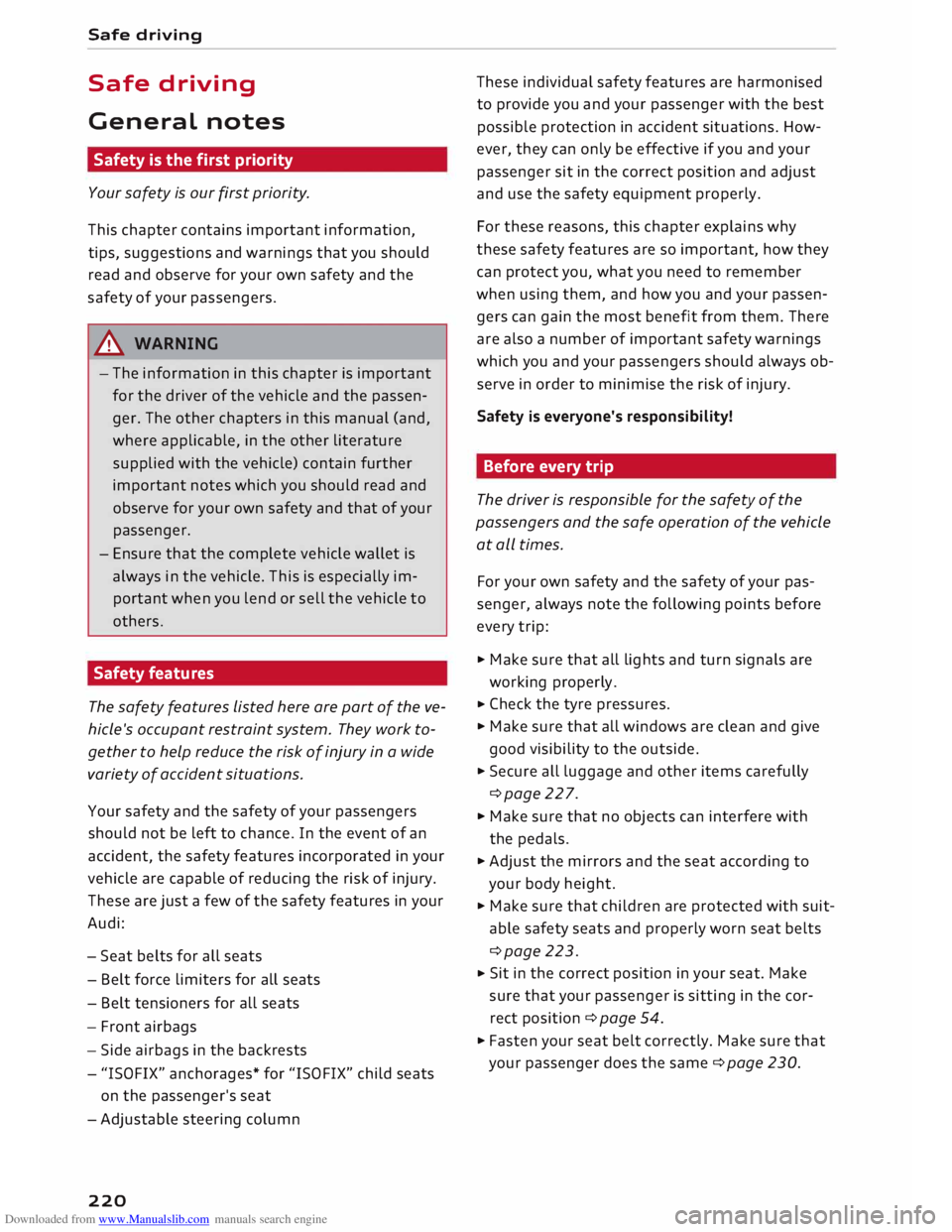
Downloaded from www.Manualslib.com manuals search engine Safe
driving
Safe driving
General notes
Safety is the first priority
Your safety is our first priority.
This chapter contains important information,
tips, suggestions and warnings that you should
read and observe for your own safety and the
safety of your passengers.
A WARNING
- The information in this chapter is important
for the driver of the vehicle and the passen
ger. The other chapters in this manual (and,
where applicable, in the other literature
supplied with the vehicle) contain further
important notes which you should read and
observe for your own safety and that of your
passenger.
- Ensure that the complete vehicle wallet is
always in the vehicle. This is especially im
portant when you lend or sell the vehicle to
others.
Safety features
The safety features Listed here are part of the ve
hicle's occupant restraint system. They work to
gether to help reduce the risk of injury in a wide
variety of accident situations.
Your safety and the safety of your passengers
should not be left to chance. In the event of an
accident, the safety features incorporated in your
vehicle are capable of reducing the risk of injury.
These are just a few of the safety features in your
Audi:
- Seat belts for all seats
- Belt force limiters for all seats
- Belt tensioners for all seats
- Front airbags
- Side airbags in the backrests
- "ISOFIX" anchorages* for "ISO FIX" child seats
on the passenger's seat
-Adjustable steering column
220 These
individual safety features are harmonised
to provide you and your passenger with the best
possible protection in accident situations. How
ever, they can only be effective if you and your
passenger sit in the correct position and adjust
and use the safety equipment properly.
For these reasons, this chapter explains why
these safety features are so important, how they
can protect you, what you need to remember
when using them, and how you and your passen
gers can gain the most benefit from them. There
are also a number of important safety warnings
which you and your passengers should always ob
serve in order to minimise the risk of injury.
Safety is everyone's responsibility!
Before every trip
The driver is responsible for the safety of the
passengers and the safe operation of the vehicle
at all times.
For your own safety and the safety of your pas
senger, always note the following points before
every trip:
.,. Make sure that all lights and turn signals are
working properly .
... Check
the tyre pressures.
... Make sure that all windows are clean and give
good visibility to the outside.
... Secure all luggage and other items carefully
¢page 227.
... Make sure that no objects can interfere with
the pedals.
... Adjust the mirrors and the seat according to
your body height.
.,. Make sure that children are protected with suit
able safety seats and properly worn seat belts
¢page 223.
... Sit
in the correct position in your seat. Make
sure that your passenger is sitting in the cor
rect position ¢ page 54.
... Fasten your seat belt correctly. Make sure that
your passenger does the same¢ page 230.
Page 225 of 306
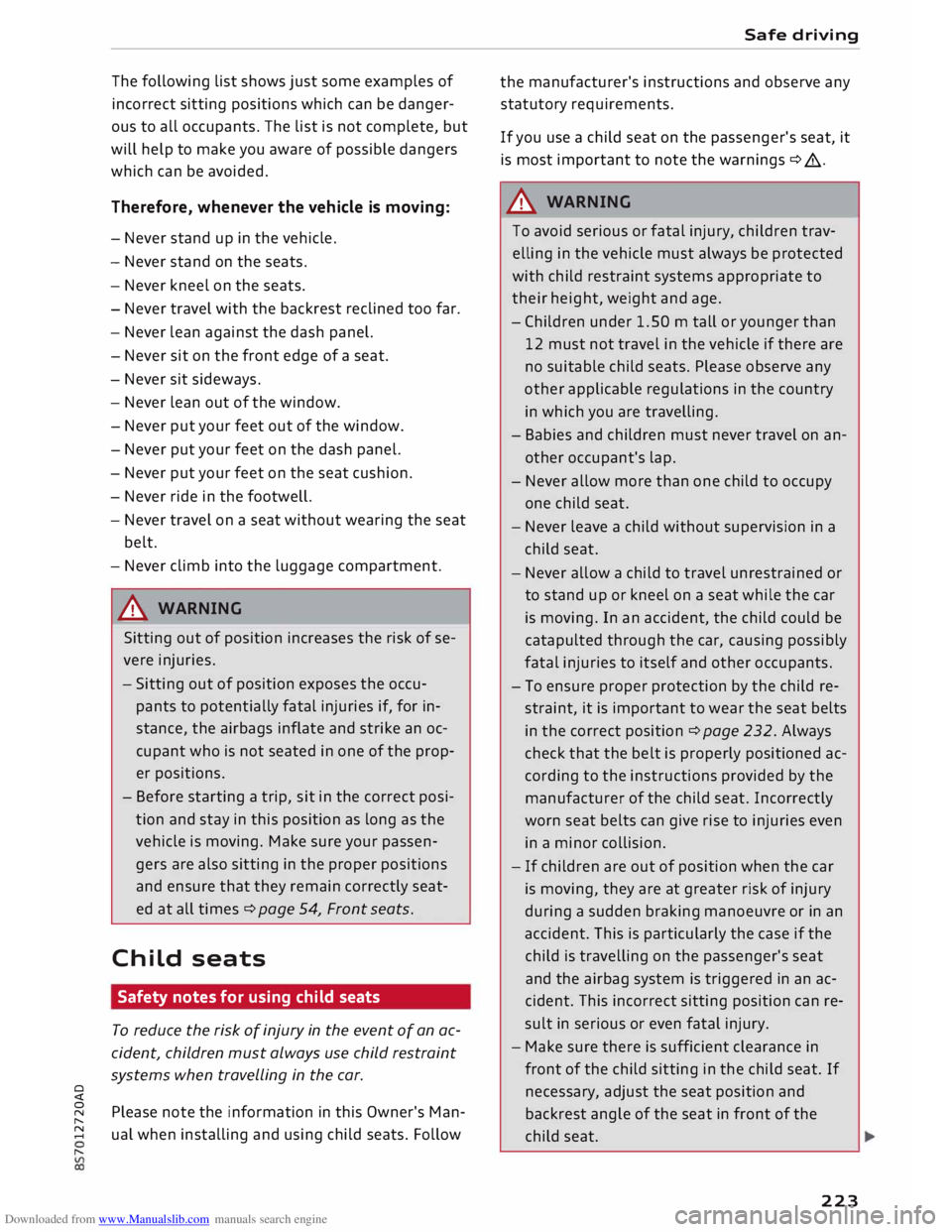
Downloaded from www.Manualslib.com manuals search engine 0
incorrect sitting positions which can be danger
ous to all occupants. The list is not complete, but
will help to make you aware of possible dangers
which can be avoided.
Therefore, whenever the vehicle is moving:
- Never stand up in the vehicle.
- Never stand on the seats.
- Never kneel on the seats.
- Never travel with the backrest reclined too far.
- Never lean against the dash panel.
- Never sit on the
front
edge of a seat.
- Never sit sideways.
- Never lean out of the window.
- Never put your feet out of the window.
- Never put your feet on the dash panel.
- Never put your feet on the seat cushion.
- Never ride in the footwell.
- Never travel on a seat without wearing the seat
belt.
- Never climb into the luggage compartment.
A WARNING
Sitting out of position increases the risk of se
vere injuries.
- Sitting out of position exposes the occu
pants to potentially fatal injuries if, for in
stance, the airbags inflate and strike an oc
cupant who is not seated in one of the prop
er positions.
- Before starting a trip, sit in the correct posi
tion and stay in this position as long as the
vehicle is moving. Make sure your passen
gers are also sitting in the proper positions
and ensure that they remain correctly seat
ed at all times ¢ page 54, Front seats.
Child seats
Safety notes for using child seats
To reduce the risk of injury in the event of an ac
cident, children must always use child restraint
systems when travelling in the car.
� Please note the information in this Owner's Man-
,.....
� ual when installing and using child seats. Follow
,..... Safe
driving
the manufacturer's instructions and observe any
statutory requirements.
If you use a child seat on the passenger's seat, it
is most important to note the warnings ¢.&..
A WARNING
To avoid serious or fatal injury, children trav
elling in the vehicle must always be protected
with child restraint systems appropriate to
their height, weight and age.
- Children under 1.50 m tall or younger than
12 must not travel in the vehicle if there are
no suitable child seats. Please observe any
other applicable regulations in the country
in which you are
travelling.
- Babies and children must never travel on an
other occupant's lap.
- Never allow more than one child to occupy
one child seat.
- Never leave a child without supervision in a
child seat.
- Never allow a child to travel unrestrained or
to stand up or kneel on a seat while the car
is moving. In an accident, the child could be
catapulted through the car, causing possibly
fatal
injuries
to itself and other occupants.
- To ensure proper protection by the child re
straint, it is important to wear the seat belts
in the correct position ¢ page 232. Always
check that the belt is properly positioned ac
cording to the instructions provided by the
manufacturer of the child seat. Incorrectly
worn seat belts can give rise to injuries even
in a minor collision.
- If children are out of position when the car
is moving, they are at greater risk of injury
during a sudden braking manoeuvre or in an
accident. This is particularly the case if the
child is travelling on the passenger's seat
and the airbag system is triggered in an ac
cident. This incorrect sitting position can re
sult in serious or even fatal injury.
- Make sure there is sufficient clearance in
front of the child sitting in the child seat. If
necessary, adjust the seat position and
backrest angle of the seat in front of the
child seat.
223
Page 226 of 306
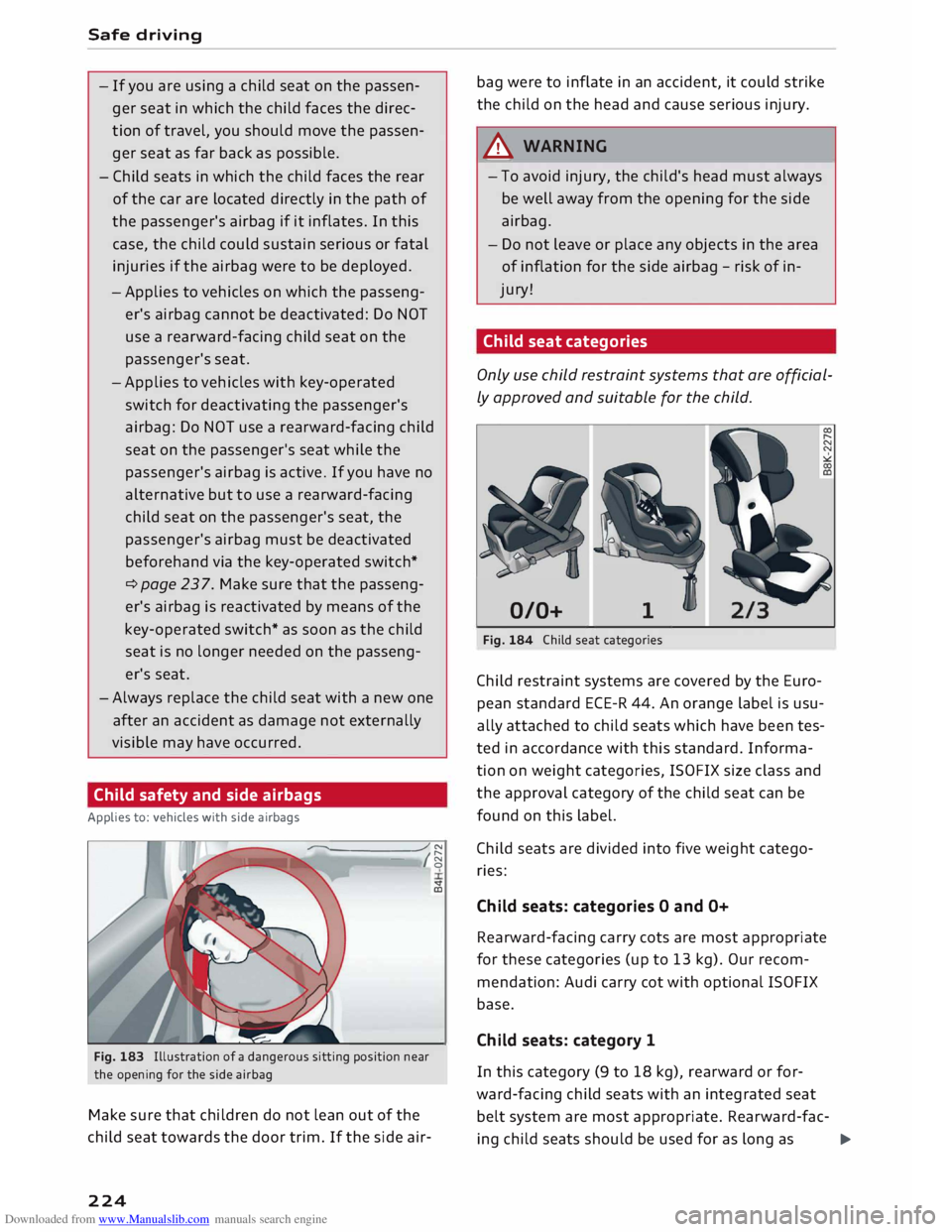
Downloaded from www.Manualslib.com manuals search engine Safe
driving
- If you are using a child seat on the passen
ger seat in which the child faces the direc
tion of travel, you should move the passen
ger seat as far back as possible.
- Child seats in which the child faces the rear
of the car are located directly in the path of
the passenger's airbag if it inflates. In this
case, the child could sustain serious or fatal
injuries if the airbag were to be deployed.
- Applies to vehicles on which the passeng
er's airbag cannot be deactivated: Do NOT
use a rearward-facing child seat on the
passenger's seat.
- Applies to vehicles with key-operated
switch for deactivating the passenger's
airbag: Do NOT use a rearward-facing child
seat on the passenger's seat while the
passenger's airbag is active. If you have no
alternative but to use a rearward-facing
child seat on the passenger's seat, the
passenger's airbag must be deactivated
beforehand via the key-operated switch*
¢ page 237. Make sure that the passeng
er's airbag is reactivated by means of the
key-operated switch* as soon as the child
seat is no longer needed on the passeng
er's seat.
- Always replace the child seat with a new one
after an accident as damage not externally
visible may have occurred.
Child safety and side airbags
Applies to: vehicles with side airbags
_/N
-
:::::
==: =::--
1�
Fig. 183 Illustration of a dangerous sitting position near
the opening for the side airbag
Make sure that children do not lean out of the
child seat towards the door trim. If the side air-
224 V
CD bag
were to inflate in an accident, it could strike
the child on the head and cause serious injury.
A WARNING
- To avoid injury, the child's head must always
be well away from the opening for the side
airbag.
- Do not leave or place any objects in the area
of inflation for the side airbag -risk of in
jury!
Child seat categories
Only use child restraint systems that are official
ly approved and suitable for the child.
0/0+ 1
Fig. 184 Child seat categories
Child restraint systems are covered by the Euro
pean standard ECE-R 44. An orange label is usu
ally attached to child seats which have been tes
ted in accordance with this standard. Informa
tion on weight categories, ISO FIX size class and
the approval category of the child seat can be
found on this label.
Child seats are divided into five weight catego
ries:
Child seats: categories O and O+
Rearward-facing carry cots are most appropriate
for these categories (up to 13 kg). Our recom
mendation: Audi carry cot with optional ISOFIX
base.
Child seats: category 1
In this category (9 to 18 kg), rearward or for
ward-facing child seats with an integrated seat
belt system are most appropriate. Rearward-fac-
ing child seats should be used for as long as
.,..
Page 238 of 306
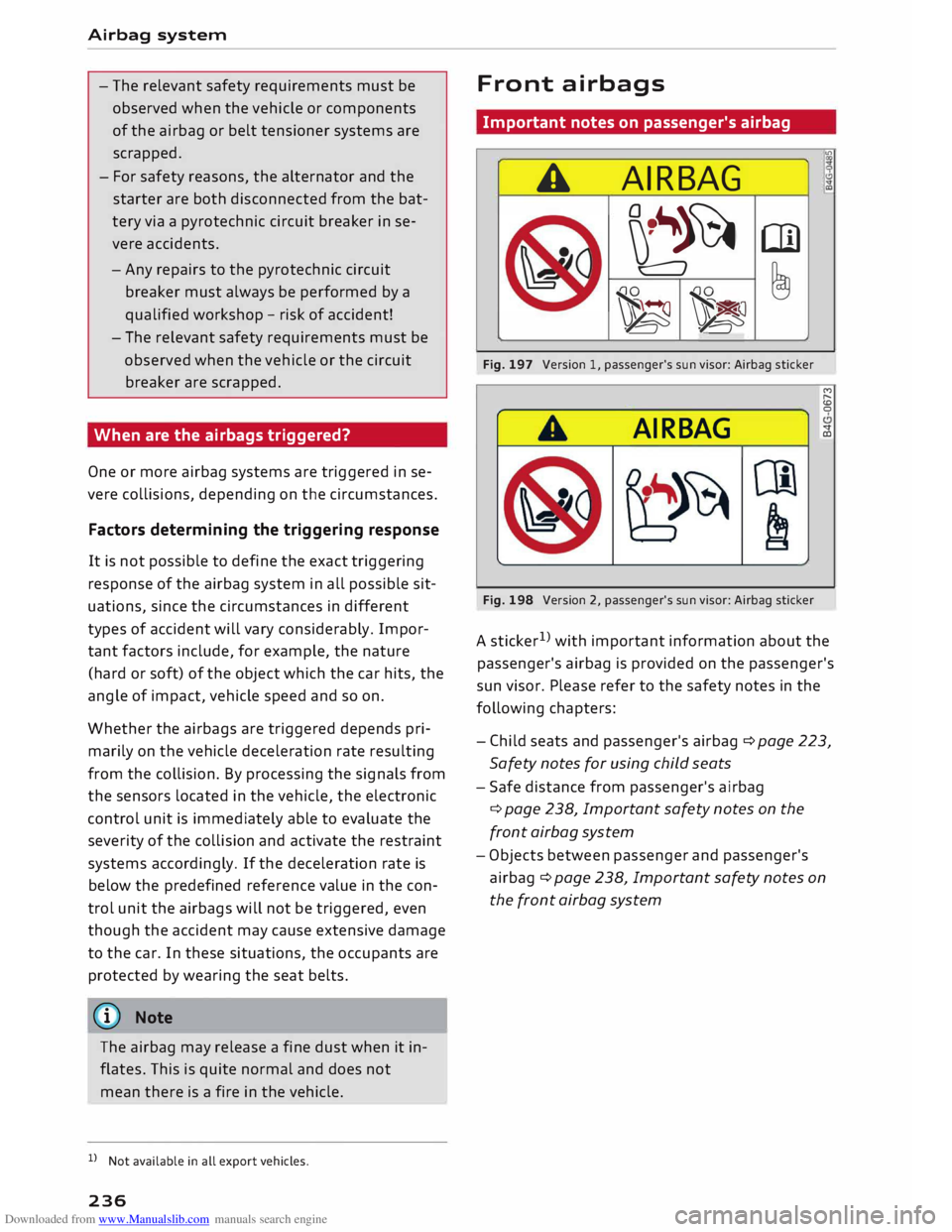
Downloaded from www.Manualslib.com manuals search engine Airbag
system
- The relevant safety requirements must be
observed when the vehicle or components
of the airbag or belt tensioner systems are
scrapped.
- For safety reasons, the alternator and the
starter are both disconnected from the bat
tery via a pyrotechnic circuit breaker in se
vere accidents.
- Any repairs to the pyrotechnic circuit
breaker must always be performed by a
qualified workshop -risk of accident!
- The relevant safety requirements must be
observed when the vehicle or the circuit
breaker are scrapped.
When are the airbags triggered?
One or more airbag systems are triggered in se
vere collisions, depending on the circumstances.
Factors determining the triggering response
It is not possible to define the exact triggering
response of the airbag system in all possible sit
uations, since the circumstances in different
types of accident will vary considerably. Impor
tant factors
include,
for example, the nature
(hard or soft) of the object which the car hits, the
angle of impact, vehicle speed and so on.
Whether the airbags are triggered depends pri
marily on the vehicle deceleration rate resulting
from the collision. By processing the signals from
the sensors located in the vehicle, the electronic
control unit is immediately able to evaluate the
severity of the collision and activate the restraint
systems accordingly. If the deceleration rate is
below the predefined reference value in the con
trol unit the airbags will not be triggered, even
though the accident may cause extensive damage
to the car. In these situations, the occupants are
protected by wearing the seat belts.
({D Note
The airbag may release a fine dust when it in
flates. This is quite normal and does not
mean there is a fire in the vehicle.
1 1
Not available in all export vehicles.
236 Front
airbags
Important notes on passenger's airbag
A AIRBAG
t '�
'\34 CII)
c:::::J
®
ClO
ClO
\t'� J�
a
-� �:&
Fig. 197 Version 1, passenger's sun visor: Airbag sticker
AIRBAG
Fig. 198 Version 2, passenger's sun visor: Airbag sticker "'
M
....
c.o 0
"
A sticker 1
>
with important information about the
passenger's airbag is provided on the passenger's
sun visor. Please refer to the safety notes in the
following chapters:
- Child seats and passenger's airbag c:::> page 223,
Safety notes for using child seats
- Safe distance from passenger's airbag
c:::> page 238, Important safety notes on the
front airbag system
- Objects between passenger and passenger's
airbag c:::> page 238, Important safety notes on
the front airbag system
Page 240 of 306
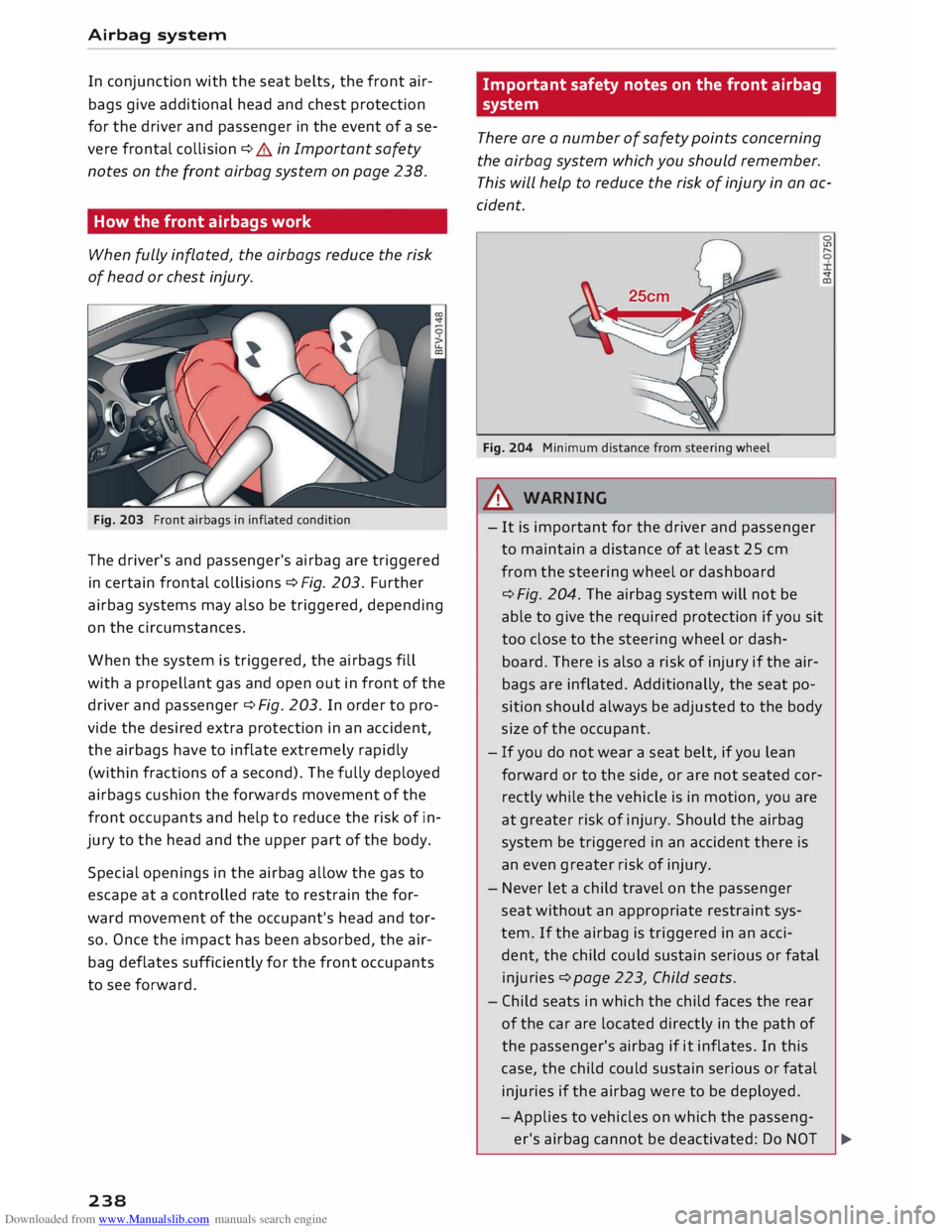
Downloaded from www.Manualslib.com manuals search engine Airbag
system
In conjunction with the seat belts, the front air
bags give additional head and chest protection
for the driver and passenger in the event of a se
vere frontal collision <=> A in Important safety
notes on the front airbag system on page 238.
How the front airbags work
When fully inflated, the airbags reduce the risk
of head or chest injury.
Fig. 203 Front airbags in inflated condition
The driver's and passenger's airbag are triggered
in certain frontal collisions c:> Fig. 203. Further
airbag systems may also be triggered, depending
on the circumstances.
When the system is triggered, the airbags fill
with a propellant gas and open out in front of the
driver and passenger<=> Fig. 203. In order to pro
vide the desired extra protection in an accident,
the airbags have to inflate extremely rapidly
(within fractions of a second). The fully deployed
airbags cushion the forwards movement of the
front occupants and help to reduce the risk of in
jury to the head and the upper part of the body.
Special openings in the airbag allow the gas to
escape at a controlled rate to restrain the for
ward movement of the occupant's head and tor
so. Once the impact has been absorbed, the air
bag deflates sufficiently for the front occupants
to see forward.
238 Important
safety notes on the front airbag
system
There are a number of safety points concerning
the airbag system which you should remember.
This will help to reduce the risk of injury in an ac
cident.
Fig. 204 Minimum distance from steering wheel
A WARNING 0
U'>
r--
0
�
co
- It is important for the driver and passenger
to maintain a distance of at least 25 cm
from the steering wheel or dashboard
<=> Fig. 204. The airbag system will not be
able to give the required protection if you sit
too close to the steering wheel or dash
board. There is also a risk of injury if the air
bags are inflated. Additionally, the seat po
sition should always be adjusted to the body
size of the occupant.
- If you do not wear a seat belt, if you lean
forward or to the side, or are not seated cor
rectly while the vehicle is in motion, you are
at greater risk of injury. Should the airbag
system be triggered in an accident there is
an even greater risk of injury.
- Never let a child travel on the passenger
seat without an appropriate restraint sys
tem. If the airbag is triggered in an acci
dent, the child could sustain serious or fatal
injuries c:> page 223, Child seats.
- Child seats in which the child faces the rear
of the car are located directly in the path of
the passenger's airbag if it inflates. In this
case, the child could sustain serious or fatal
injuries if the airbag were to be deployed.
- Applies to vehicles on which the passeng-
er's airbag cannot be deactivated: Do NOT
�